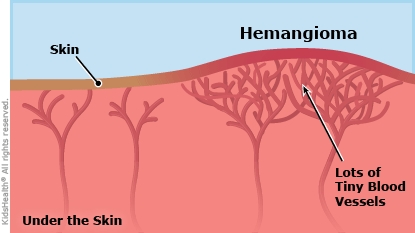An infantile hemangioma (he-man-jee-OH-muh) is a type of birthmark. It is made up of tiny blood vessels and is usually red or purple. The appearance of hemangiomas can vary from person to person. They might be flat or bulging, small or large, bumpy or smooth. Most infantile hemangiomas are on the skin, but they also can be on the inside of the body. They usually go away on their own, but some might need treatment.




What causes infantile hemangiomas and who gets them? Doctors do not fully understand how infantile hemangiomas form. They are more common in girls, in multiple births (such as twins or triplets), and in babies who are born prematurely (early).
Will my child's infantile hemangioma go away? Most infantile hemangiomas show up a few days or weeks after a baby is born. They can get bigger at first, but most start to go away when children are 6–18 months old. They slowly fade and flatten, and most will be gone (or almost gone) by the time a child is 5 years old. Sometimes a scar or other change in the skin can remain.
Does my child need any testing for the hemangioma? Often, no testing is needed. If a baby has many hemangiomas on the skin, though, a health care provider might order an ultrasound or an MRI (magnetic resonance imaging) test to see if any hemangiomas are inside the body.
When does a hemangioma need treatment? The health care provider may recommend medicine, surgery, or other treatment if a hemangioma: